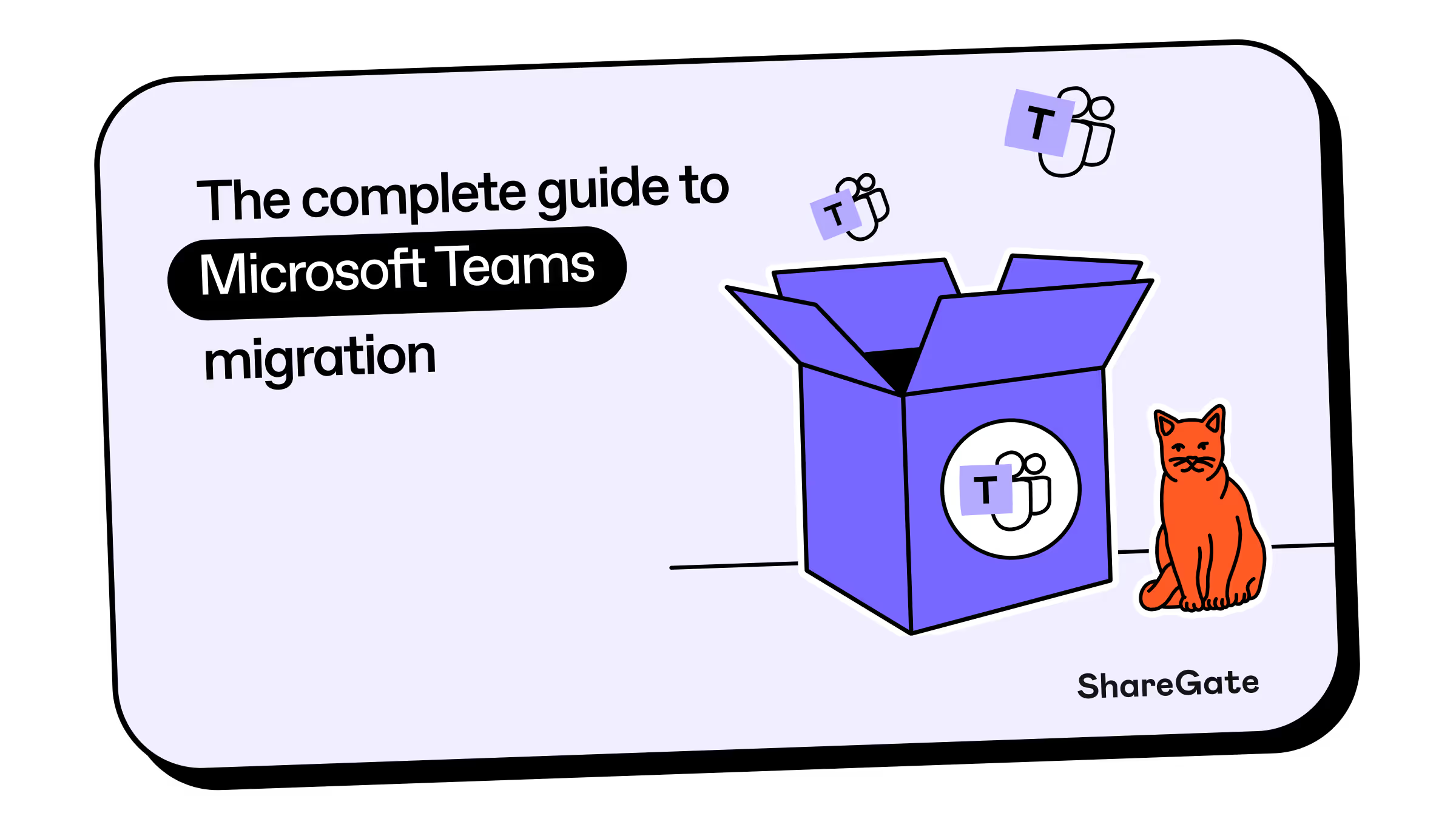Your go-to Microsoft Teams migration guide
Ensure a successful migration from the start with the only guide that simplifies your Teams migration project and supports you at every step.

The complete guide to Microsoft Teams migration
Teams migration can mean a lot of things—from reorganizing the contents of your existing tenant, to moving your entire environment to a new tenant in the event of a merger or acquisition.
With more than a decade of experience under our belt, we’ve just about seen it all when it comes to migration scenarios, and have helped organizations of all shapes along the journey to a more organized and secure Teams environment.
We’ve put together this handy guide as your go-to when undertaking your own migration project so you can rest easy knowing that you’re well on your way to migrating Teams successfully.
Pre-migration: Strategy and planning
Planning is key to a successful Microsoft Teams migration. Before you even get started, you have some important decisions to make that will affect the outcome of your big move.
Choosing a migration method: manual vs. third-party tool
Before you begin your migration, you have one very important decision to make: do you want to complete this migration manually, or enlist the help of a third-party tool?
When it comes to executing a Teams tenant-to-tenant migration, Microsoft does not provide any kind of simple out-of-the-box solution. This leaves you with two options:
- Migrate Microsoft Teams from one tenant to another manually
- ShareGate’s customizable migration solution
If you want to avoid investing in a third-party tool, you can accomplish a Teams tenant-to-tenant migration manually, albeit the process is lengthy and convoluted.
To migrate your Microsoft Teams to another tenant manually, you need to:
- Re-create the teams you want to migrate at the destination
- Add all of the correct users and permissions to each team
- Download the contents of the associated SharePoint team sites and upload at the destination
- Export conversations from the team’s Exchange mailbox, then import them at the destination as a document
A manual approach is resource-intensive, leaves opportunities for error, and requires IT teams to develop new competencies that may not be leveraged often (or again). Using a third-party tool can save you time and manpower, not to mention the headache of making sure all of your valuable resources are accounted for.
📈 Take it further: Step-by-step instructions on how to migrate Microsoft Teams from one tenant to another, manually or using ShareGate
Choosing a migration strategy: Phased or single-event
After deciding to migrate Teams manually or leave the heavy lifting to a third-party tool, you’ll have to decide whether it makes more sense for your organization to migrate data in one shot, or incrementally.
A single-event migration allows you to transfer your entire environment quickly, albeit with higher risk. This type of migration is typically limited to environments of less than 15,000 users or 7 TB of content.
A phased migration is a gradual migration of your teams, users, and content that is lower risk but takes more time to complete. This type of migration is more conducive to keeping a positive user experience, with the option to move only what’s changed since your last migration.
🔑 Key takeaways: Benefits of migrating teams incrementally with ShareGate’s migration tool.
During your Microsoft Teams migration
Once you’ve got a solid plan in place, you’re ready to go! Here are a few things to keep in mind while in the midst of your big move.
Preparing end users for migration
Whatever kind of Teams migration you’re planning, you need to make sure you’re taking care of your end-users to ensure your organization remains productive.
A good place to start? Transparent Communication via email is a good way to open the door to users, allowing them to develop an understanding of the upcoming migration, ask questions, and provide feedback. Keeping the process transparent is a key factor in increasing user adoption and creating power users.
To help you tailor your communication strategy during the migration planning phase, we decided to share a series of sample emails that gets the conversation started in the context of a Microsoft Teams tenant-to-tenant migration.
%2520(1).avif)
Monitoring during your Microsoft Teams migration
Monitoring is key to understanding the current state of your Teams environment and maintaining efficiency and productivity throughout your migration.
Monitoring can help you get to the root of potential issues quickly and fix them.
Here’s a list of some things to look out for that could potentially cause issues during migration to help get you started:
- URLs (file paths) and file names
- File sizes
- Character limitations
- Custom solutions
- Branding
- InfoPath
- Workflow state and history
- Permissions (do you have access to all the files?)
- Folders with more than 5000 items
- Unsupported site templates
- Orphaned users
- Checked out files
- Unsupported list templates
- File extensions
Using a third-party tool, you can run a migration report once the project is complete to see everything in your migration’s scope, including migration issues and errors, so you can focus on your troubleshooting efforts. (p.s. check out ShareGate’s in-depth migration report features)
%2520(1).avif)
👀 What to look out for: 5 common Microsoft Teams migration challenges
Migrate membership and permissions
Microsoft doesn’t offer an out-of-the-box solution to replicate team membership and permissions in Microsoft Teams. You want to make sure that everything makes it to the destination with all of its accesses and permissions intact.
In the course of a manual migration, you’ll need to generate a list of details about your existing Microsoft Teams. There’s no way to do this using Microsoft tools, so hopefully, you’re comfortable with scripting!
To export details about all of the teams in your source tenant, you can run a slightly modified version of this PowerShell script. Note: make sure you have the SharePoint Online PnP PowerShell module installed in order to run this script.
Otherwise, you can use a third-party tool to automatically map users at the destination. That way, you’re sure the right people have access to the right teams with the right set of permissions.
With ShareGate’s migration tool, you can bring along:
- Team settings and description
- Membership (owners and members)
- Permissions
- Conversation history (including sender, threaded messages, links, and timestamps)
- Public channels
- Lists
- Files (along with their history and metadata)
- Tabs
- Apps and bots (those that are available in the App Store)
- SharePoint site customizations
- Default wiki pages
- OneNotes
- Planner plans
Avoiding data loss during a migration
One of the biggest migration concerns is data protection and ensuring that nothing is lost along the way. The best way to do this is by careful planning and taking inventory of all of your valuable data that you want to migrate.
Before you can back up your data, you need to know where it’s stored. This is one of the primary challenges of performing a Teams migration because there’s no centralized location for all of your data in Teams. Depending on what you’re looking for, you’ll find it in various locations across your Microsoft 365 apps and tools.
%2520(1).avif)
While Microsoft does not provide any kind of out-of-the-box solution to back up your Teams data, you can put policies in place to protect and prevent it from being deleted.
🔎 Find out more: using retention policies and labels to protect your valuable Microsoft Teams data.
After your Microsoft Teams migration
Your migration might be done, but you’re not out of the woods yet! There are a few key steps you need to take post-migration to ensure a seamless migration experience.
Post-migration management of Microsoft Teams
Come up with a plan for ongoing maintenance and management of your environment. A solid management plan includes the following:
- Implement a naming convention for your Microsoft Teams: It’s challenging to manage your teams if you don’t know why they exist or what they’re used for. Whether implemented manually or enforced via a naming policy in your Azure Active Directory, creating an effective naming convention can help you and your users identify the function, membership, geographic region, and/or creator of a team.
- Plan for lifecycle management in Microsoft Teams: Planning for management at each stage of a team’s lifecycle—from the moment of creation and when a team is actively in use all the way through to archival or deletion—will help you track your organization’s projects as they go through these stages.
- Configure custom security settings for each Microsoft team: You want to give users the freedom to create new resources as they see fit—but you don’t want that freedom to come at the cost of creating a security risk. The scalable solution: configure custom security settings for your Microsoft teams based on their confidentiality and business purpose. That way, you can implement additional restrictions only where needed.
☝️ Pro tips for after the migration: top 10 tips for ongoing Teams management.
About ShareGate Academy
ShareGate Academy is ShareGate’s learning platform. We offer free, online courses on all kinds of Microsoft 365 topics, from adoption to sprawl, from Microsoft Teams to SharePoint. ShareGate Academy is here to help IT pros expand their knowledge so they can work smarter, not harder.

